8 Moves That Make You Feel 10 Years Younger
Just because you're not 25 anymore doesn't mean you can't feel strong, lean and limber.
By Emma Haak
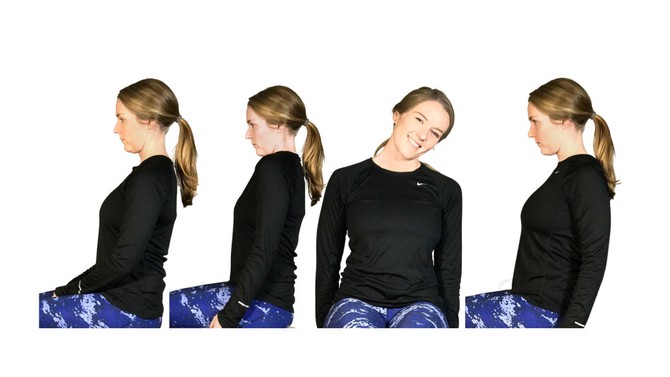
Photo: Adam Bell
Chin Tuck/Upper Trap Stretch/Shoulder Circles
What it does: This sequence releases tightness in the back of your neck, your shoulders, and the muscles that connect your shoulders to the base of your skull. Not only do these areas get tighter with age, but sitting all day (especially when you're slumped forward) speeds up that process, says Mary Ann Wilmarth, a certified physical therapist and a spokesperson for the American Physical Therapy Association.
How to do it: While you're sitting in a chair with good posture (shoulders back and down), slide your head back like you're trying to give yourself a double chin. Keep your head there, hold onto the side of the chair with your right hand and tilt your head toward your left shoulder. You should feel a stretch in the right side of your neck. Hold for 10 seconds, then switch sides. Finally, with your chin still tucked, do 5 to 10 backwards shoulder circles. Repeat the sequence 3 to 5 times throughout the day.
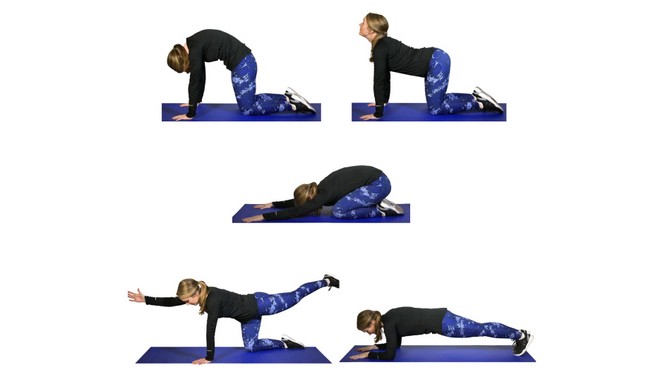
Photo: Adam Bell
Cat & Cow/Child's Pose/Bird Dog/Plank
What it does: Stretches out your lower back and strengthens the muscles in your back and core, which get weaker as we get older. Stronger, more-flexible back muscles will help you maintain better posture, says Wilmarth, "which immediately helps you feel younger."
How to do it: Start in a tabletop position on the ground and squeeze your abs to round your back up toward the sky. Hold for a second, then let gravity pull your stomach toward the floor so your back is arched. Repeat that 5 to 10 times, then sink back into child's pose, keeping your arms outstretched on the ground in front of you and trying to get your forehead and stomach to touch the ground. Hold for 15 seconds. Rise back up into tabletop position and lift your right arm out in front of you and your left leg behind you at the same time, hold for 5 seconds, then switch arms and legs and repeat for a total of 10 reps. Finally, get into a forearm plank position, keeping a straight line from your shoulders to your feet, and hold for 30 seconds.
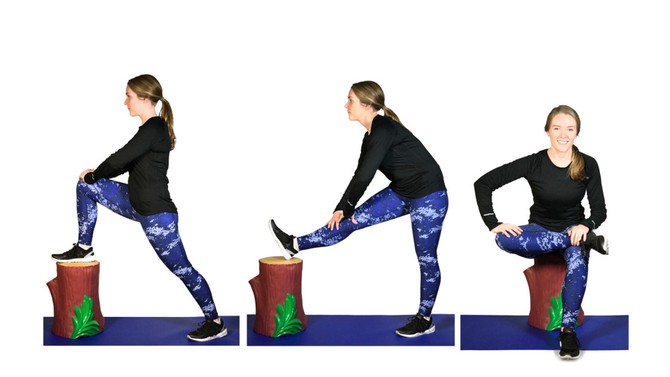
Photo: Adam Bell
Hip Flexor/Hamstring/Glute Stretches
What it does: Focuses on tightness in your hip flexors, your hamstrings and your glutes, which all get tighter and weaker with time (especially if you spend a lot of that time sitting).
How to do it: Find a table that's about hip height (if that's too high for you, it's fine to use a lower surface, like a chair, at first). Place your right foot on top of it and, keeping your left foot on the ground and left leg straight, bend your right knee and lean in toward your right knee, keeping your back straight as you do it. You should feel a stretch in the front of your left hip. Hold for 10 seconds, then switch sides. Next, grab a chair and place your right foot on the seat. Flex your right foot, keep both legs straight and stick your butt out behind you as you hinge forward from the hip and keep your back straight, folding your torso over your right leg until you feel a stretch in your right hamstring. Hold for 10 seconds, then switch legs. Finally, sit on the chair and place your right ankle just above your left knee, with your left foot still on the ground. Let your right knee drop toward the ground, feeling the stretch in your right glute. (You can gently press on your right knee with your hand to deepen the stretch). Hold for 10 seconds, then switch legs.
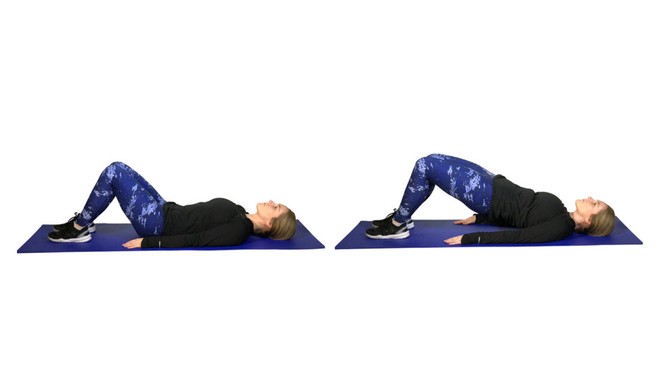
Photo: Adam Bell
Glute Bridge
What it does: Some of the most noticeable age-related declines in strength happen in the muscles that propel us forward, like the glutes, says Kyle Stull, senior master trainer and faculty instructor for the National Academy of Sports Medicine. In addition to building strength in the glutes, this move also works your core muscles, so you can maintain good posture and balance.
How to do it: Lie on the ground, hands at your sides, feet on the ground and knees bent at 90-degree angles. Squeeze your core and your glutes to lift your hips toward the ceiling. Try to get them high enough so there's a straight line from your chest to your knees. Hold for 5 seconds, bring your hips back to the floor (still squeezing your core and glutes), and repeat for 12 reps, then do two more sets.

Photo: Adam Bell
Standing Wall Slide
What it does: This works on strength and flexibility in your shoulder muscles.
How to do it: Stand against a wall, with your glutes and the back of your head touching the wall. Keep your arms at your sides as you press the back of your hands and arms against the wall. Maintain that pressure as you slide your arms out wide and up over your head. Bring your arms back down, and repeat for 12 reps, then do two more sets.
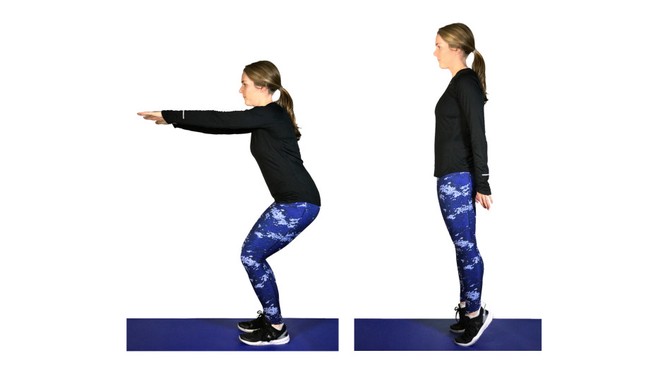
Photo: Adam Bell
Squat to Triple Extension
What it does: Works your quads, glutes and calves, the muscles that help you slow down. "Being unable to decelerate is one of the top causes of injury as we age," says Skull.
How to do it: Stand with your feet hip width apart and toes pointing forward. Lower down 1/3 or 1/4 of the way into a squat, then drive up out of the squat and up onto your toes, like you're doing a calf raise. Instead of holding at the top, immediately drop back down into your squat, hold it for a few seconds, then repeat, for 8 to 10 reps total.
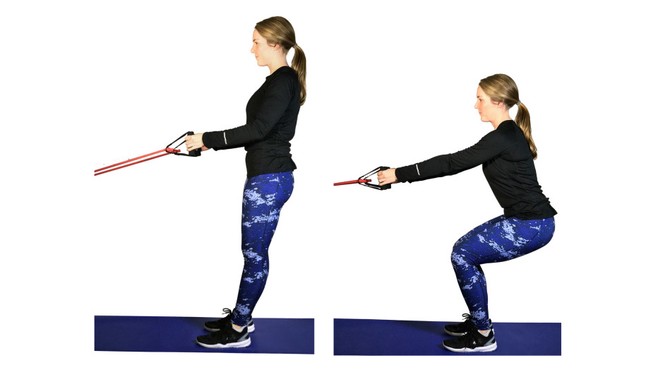
Photo: Adam Bell
Squat and Row
What it does: It strengths the glutes/quads/hamstrings and all of the muscles in your back.
How to do it: Grab the handles of a cable machine, with the cables attached at the bottom of the machine, and step back a few feet. (If you don't have access to a cable machine at your gym, you can secure a resistance band around the base of a sturdy piece of furniture at home.) Stand with your feet hip width apart and your toes pointed straight ahead. Extend your arms out in front of you (there should be no slack in the cable or resistance band), shift your hips back and lower down into a half-squat. Press through your heels to come back to standing as you pull the cables toward your rib cage. Do up to 3 sets of 12 reps.
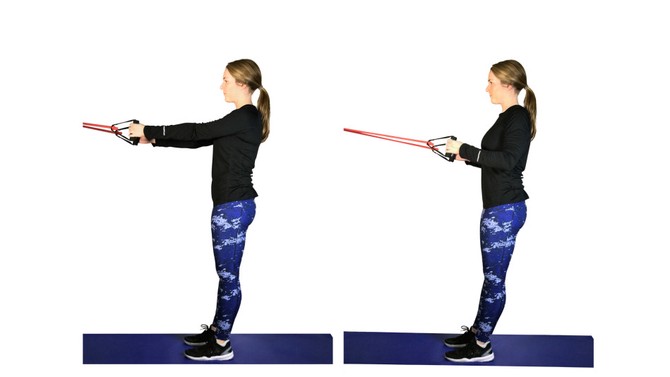
Photo: Adam Bell
Standing Row
What it does: Focuses on your back again, and here's why: Those muscles are some of the first to lose strength with age, says Stull, and the more back-focused moves you do, the more you'll be able to prevent or counteract that decline.
How to do it: Using a cable machine with the cables attached at shoulder height (again, if you don't have a cable machine handy, secure a resistance band around some sturdy furniture), face the machine, hold the cable handles and step back a few feet, keeping your feet wider than hip width apart. Squeeze your abs and pull the bands by bringing your shoulder blades together, then pulling with your arms. Return to starting position. Do up to 3 sets of 12 reps.
Want more stories like this delivered to your inbox? Sign up for the Oprah.com Healthy Body Newsletter!
Published 02/23/2017

